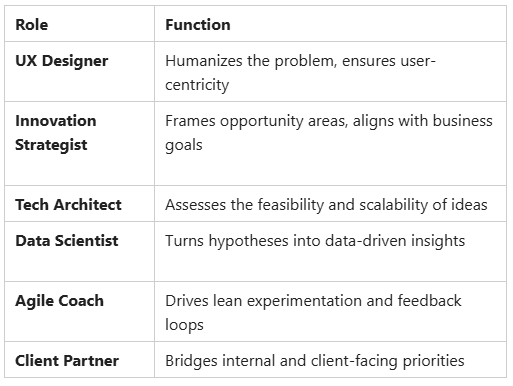Blog
The Co-Innovation Approach to Creating Value with Clients
Explore how co-innovation is redefining enterprise growth. Learn actionable strategies to build scalable, collaborative innovation models that drive real business outcomes—together with clients and partners.
November 13, 2025

Introduction
What if your next breakthrough didn’t come from inside your company but from your clients? The most valuable ideas often emerge at the intersection of business and customer needs. From generative AI to green tech, and from decentralized ecosystems to shifting regulatory landscapes, disruption is constant. Traditional models of innovation—where R&D works in isolation and hands—off solutions are downstream—are no longer enough.
Forward-looking organizations are flipping that model entirely. They’re not just building solutions for their clients—they’re building with them. This is the essence of co-innovation: a strategic, collaborative process where businesses and clients join forces to solve complex challenges, develop differentiated offerings, and co-create entirely new value pools.
This article offers a practical playbook for turning co-innovation into a repeatable, scalable capability that delivers tangible outcomes—not just ideas.
Reframing the Relationship: From Vendor to Value Creator
The traditional client-vendor relationship is rooted in deliverables: a project is scoped, contracted, and executed. But this transactional model often limits agility, experimentation, and long-term impact. In contrast, co-innovation is a partnership model that emphasizes:
- Shared vision and joint accountability
- Agile experimentation and iterative design
- Outcome-based metrics over activity-based contracts
- Continuous engagement versus one-time delivery
Leading organizations are embedding co-innovation at the heart of their client engagement strategy. For instance, instead of pitching pre-built solutions, they bring clients into the ideation and prototyping phases. This approach not only builds trust but also aligns solutions more closely with real-world needs, accelerating adoption and ROI.
The Five Pillars of a Co-Innovation Operating Model
For co-innovation to succeed, enterprises need a structured model that supports agility, experimentation, and accountability. Based on best practices observed across high-performing innovation ecosystems, here are the five foundational pillars of a co-innovation operating model:
1. Shared Vision and Strategic Alignment
Start with clarity on the ‘why’. Co-innovation efforts must align with both organizations’ business goals and customer outcomes. A shared North Star fosters commitment beyond individual projects.
2. Dedicated Cross-Functional Squads
Move away from siloed roles. Form joint squads comprising product managers, engineers, data scientists, domain experts, and client stakeholders. These teams operate as co-owners, not service providers.
3. Agile Governance and Decision-Making
Governance must be flexible enough to accommodate change without bottlenecks. Establish joint steering committees, rapid decision protocols, and lean funding models that support quick pivots.
4. IP, Data, and Risk Sharing Frameworks
Establish upfront agreements on how co-developed IP will be owned, licensed, and monetized. Address data sharing, privacy, and liability concerns early to avoid roadblocks midstream.
5. Measurement, Learning, and Scaling
Define shared success metrics that go beyond delivery (e.g., market impact, revenue growth, NPS). Build retrospectives into the process. Use pilots to validate hypotheses, then invest in scaling proven solutions.
Together, these five pillars ensure that co-innovation moves beyond good intentions and becomes a repeatable, value-generating practice—at scale.
Building the Right Team: Roles and Skills Required
To make co-innovation work, organizations need more than domain experts—they need boundary spanners. These are professionals who can navigate across business, design, and technology functions.
Key roles in a co-innovation squad include:

The combination of deep expertise and a collaborative mindset is non-negotiable. According to a study by Cloverpop, inclusive teams make better business decisions up to 87% of the time.
Technology as a Co-Innovation Enabler
In any co-innovation model, strategy alone is not enough. Technology is the connective tissue that enables rapid iteration, real-time collaboration, and scalable value creation. A purpose-built digital environment reduces time-to-value, unlocks experimentation at scale, and allows ideas to move from concept to deployment with speed and confidence.
Modern co-innovation programs increasingly rely on the following technological capabilities:
- Digital Twin Sandboxes: These virtual environments simulate real-world processes, assets, and interactions, allowing cross-functional teams to test, iterate, and validate ideas before deploying them in live systems. In sectors like manufacturing and logistics, digital twins have significantly reduced both design flaws and time-to-market.
- Low-Code/No-Code Platforms: These platforms democratize innovation by enabling business users—not just developers—to prototype solutions quickly. This accelerates early-stage testing and fosters a more inclusive ideation process across departments.
- Composable Architecture: This modular approach to system design allows organizations to assemble and reassemble various components to meet specific business needs. It promotes flexibility and scalability, enabling enterprises to adapt swiftly to new opportunities or challenges without overhauling their entire IT infrastructure. According to Gartner, by 2024, 60% of finance organizations will seek composable finance applications in new technology investments, highlighting the growing recognition of the value of composable systems.
- API-First Integration: A co-innovation initiative often involves multiple organizations, systems, and data sources. APIs ensure seamless, real-time data sharing and interoperability across these boundaries—critical for dynamic collaboration.
- AI-Powered Co-Creation Tools: AI is evolving from an enabler to a creative partner. Generative design tools, automated insight engines, and adaptive learning models help teams explore broader solution spaces, optimize outcomes, and co-create with speed and scale.
Integrating these technological components creates an ecosystem that supports agile and effective co-innovation. By leveraging such tools, organizations can enhance their collaborative efforts, respond more rapidly to market changes, and co-create value that drives mutual growth and success.
From MVP to Market Impact: How to Scale Co-Innovation
Creating a Minimum Viable Product (MVP) is only the first milestone in the co-innovation journey. To turn ideas into enterprise-scale impact, organizations must embed structured mechanisms to scale outcomes across teams, markets, and product lines. Here’s how:
- Feedback-to-Platform Loops
Ensure every MVP outcome is fed back into enterprise platforms. Insights—both technical and experiential—should refine core products, services, and operating models.
- Defined Commercialization Pathways
Co-innovation should lead to real business value. Clearly outline how MVPs will become monetizable solutions—through licensing, co-branding, white-labeling, or internal rollout.
- Internal Evangelism
Build momentum through visibility. Host innovation demo days, publish case studies, and reward teams that successfully scale co-created solutions.
- Innovation as Culture, Not Just a Function
Move beyond isolated pilots. Create internal networks of innovation champions who can replicate successful patterns across business units.
- Outcome-Based Measurement
Ditch vanity metrics. Focus on KPIs that reflect business outcome, —such as time-to-market improvements, customer engagement uplift, or operational cost savings.
When co-innovation is approached as a lifecycle—not a one-off initiative—it generates real, measurable impact across the ecosystem.
Redefining Competitive Advantage Through Co-Innovation
Innovation is no longer a solo sport. In a world defined by complexity, speed, and uncertainty, the ability to co-create—with clients, partners, and ecosystems—will separate market leaders from followers.
But co-innovation doesn’t happen by chance. It requires intent, investment, and infrastructure. It demands that organizations become not just solution providers but true growth collaborators. That’s the promise of co-innovation—and the imperative for those who seek to lead in the age of agility.
Clarient helps future-ready enterprises operationalize co-innovation at scale—through platform enablement, ecosystem orchestration, and purpose-built collaboration frameworks. If you're ready to turn co-creation into a core capability, let’s explore how we can architect the future—together. Connect with Clarient to start your co-innovation journey.

Parthsarathy Sharma
B2B Content Writer & Strategist with 3+ years of experience, helping mid-to-large enterprises craft compelling narratives that drive engagement and growth.
A voracious reader who thrives on industry trends and storytelling that makes an impact.
Share
Are you seeking an exciting role that will challenge and inspire you?

GET IN TOUCH